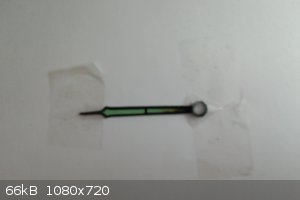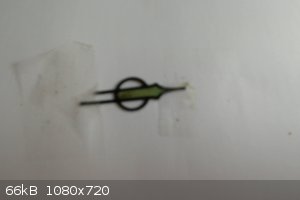
Radium212 - 26-3-2018 at 01:44
I recently acquired some large tritium clock hands, and a clock face, if anyone is interested. They'de be good in an element collection, as a test
source for Geiger/Scintillation counters, or for teaching. You can U2U me if you are.
Radium212 - 26-3-2018 at 02:41
Here's some pictures of the hands.


Radium212 - 26-3-2018 at 02:42
the big hand is around 5 cm long, the little one around 2.5cm.
Ubya - 26-3-2018 at 05:54
those look like radium watch hands, not tritium, am i wrong?
Radium212 - 26-3-2018 at 11:10
Radium hands would be more active, and the paint would be duller. It's a bad photo, but in reality the paint is far too bright to be radium (radium
paint would be a beige-ish colour).
DavidJR - 26-3-2018 at 11:51
Huh, I wasn't aware that tritium paint was possible. I'm familiar with the gaseous tritium light sources which are tiny glass tubes, with a
phosphorescent coating, filled with tritium gas.
TheNerdyFarmer - 26-3-2018 at 18:47
I seriously doubt that it is tritium although it could be. Tritium is gaseous and cannot be contained in a paint (unless compounded in the form of a
polymer) so it is usually in a small glass vial. There are patents out there claiming to use Pm147 as a radiation source since it only has a half life
of about two years. This was employed in newer watch hands so maybe, idk how old yours are.
Here is a link from ORAU I found with a couple minutes of google:
https://www.orau.org/ptp/collection/radioluminescent/radiolu...
I found that this was quite informative.
Radium212 - 27-3-2018 at 01:03
I have taken readings from promethium watches, and these hands are significantly more active. I believe that the tritium is locked inside simple
compound, or perhaps a polymer. But these are not promethium, or radium.
Bert - 27-3-2018 at 06:31
There are no Tritium "paints" AFAIK.
Tritium illumination is by glass vials with a bit of Tritium and a phosphor for the electrons (at about 6Kev, a good old fashioned CRT display uses
electrons at around 25Kev, for comparison) emmitted by the Tritium decay to activate coating the inside, these won't be emmitting anything for a
geiger counter to pick up.
Whatever you have there, it is not likely Tritium.
Radium212 - 27-3-2018 at 08:54
I arrived at tritium because I had had heard of tritium paint (http://www.moonwatchonly.com/omega-speedmaster-moonwatch/moo...), and the paint isin't active enough to be radium, and is too active to be
promethium.
[Edited on 27-3-2018 by Radium212]
Bert - 27-3-2018 at 13:49
What type of SENSOR, what brand/model of radiation meter are you using.
What are these "readings" you are taking, type, numerical value? Could you describe how you did the measurement?
Tritium wouldn't be detectable with anything ordinary amateurs have.
Radium212 - 28-3-2018 at 02:54
I read it off with a Geiger counter, and got around 3000CPM. I firstly used a modern GMC-300E, which gave more accurate, digital readings. I then used
a 1960's RBGT-62A, which gave lower sensitivity (due to the fact that I purchased it broken and repaired it myself). The RBGT gave around 2,500CPM. I
compared this to an Ra watch hand of similar size, that gave readings of around 12,000CPM, and 11,000CPM on the GMC and RBGT respectively. I also
tested some promethium watch hands, which gave around 900CPM. All readings were made at point blank range, the tube almost in contact with the sample.
phlogiston - 28-3-2018 at 06:11
The number of counts in itself doesn't say much about which isotope/element was used.
It would be more informative to examine how the counts fall off with distance, and how much you can block with things like paper, metal foil, sheet of
plastic, etc.
Radium 226 would produce mostly alpha radiation. A piece of paper would shield nearly all of it. (but there will still be some contribution from
daughter isotopes, many of which are beta emitters). alpha particles carry only a few centimes in air.
Pm-147 is a beta emitter with >200 keV particles. Paper will only block a little bit of it and it will cary several decimeters in air. You will
still see counts decrease with distance (inverse square law), but at short range the difference with radium should be easily noticeable.
H-3 is also a beta emitter, but the energy of the particles is so low that they are not able to penetrate the window of a Geiger counter. Hence, you
should not be able to detect it with a Geiger counter.
[Edited on 28-3-2018 by phlogiston]
Radium212 - 28-3-2018 at 07:48
Interesting, I didn't know that. Not sure now. It's too new a clock to be radium, and almost certainly not promethium. Perhaps it is promethium.
